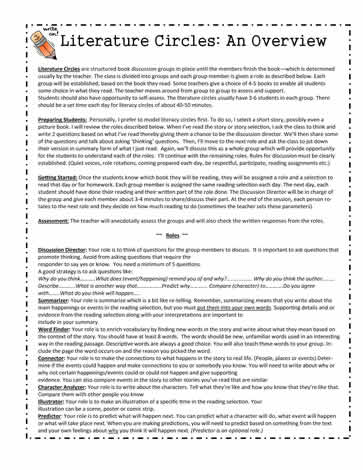| |||||
| Literature Circles are structured book discussion groups in place until the members finish the book—which is determined usually by the teacher. The class is divided into groups and each group member is given a role as described below. Each group will be established, based on the book they read. Some teachers give a choice of 4-5 books to enable all students some choice in what they read. The teacher moves around from group to group to assess and support. Students should also have opportunity to self-assess. The literature circles usually have 3-6 students in each group. There should be a set time each day for literacy circles of about 40-50 minutes. Preparing Students: Personally, I prefer to model literacy circles first. To do so, I select a short story, possibly even a picture book. I will review the roles described below. When I’ve read the story or story selection, I ask the class to think and write 2 questions based on what I’ve read thereby giving them a chance to be the discussion director. We’ll then share some of the questions and talk about asking ‘thinking’ questions. Then, I’ll move to the next role and ask the class to jot down their version in summary form of what I just read. Again, we’ll discuss this as a whole group which will provide opportunity for the students to understand each of the roles. I’ll continue with the remaining roles. Rules for discussion must be clearly established. (Quiet voices, role rotations, coming prepared each day, be respectful, participate, reading assignments etc.) Getting Started: Once the students know which book they will be reading, they will be assigned a role and a selection to read that day or for homework. Each group member is assigned the same reading selection each day. The next day, each student should have done their reading and their written part of the role done. The Discussion Director will be in charge of the group and give each member about 3-4 minutes to share/discuss their part. At the end of the session, each person rotates to the next role and they decide on how much reading to do (sometimes the teacher sets these parameters). Assessment: The teacher will anecdotally assess the groups and will also check the written responses from the roles. ~~ Roles ~~ Discussion Director: Your role is to think of questions for the group members to discuss. It is important to ask questions that promote thinking. Avoid from asking questions that require the responder to say yes or know. You need a minimum of 5 questions. A good strategy is to ask questions like: Why do you think………..What does (event/happening) remind you of and why?................. Why do you think the author……… Describe………...What is another way that……………...Predict why…………. Compare (character) to………….Do you agree with……..What do you think will happen….. Summarizer: Your role is summarize which is a bit like re-telling. Remember, summarizing means that you write about the main happenings or events in the reading selection, but you must put them into your own words. Supporting details and or evidence from the reading selection along with your interpretations are important to include in your summary. Word Finder: Your role is to enrich vocabulary by finding new words in the story and write about what they mean based on the context of the story. You should have at least 8 words. The words should be new, unfamiliar words used in an interesting way in the reading passage. Descriptive words are always a good choice. You will also teach these words to your group. Include the page the word occurs on and the reason you picked the word. Connector: Your role is to make the connections to what happens in the story to real life. (People, places or events) Determine if the events could happen and make connections to you or somebody you know. You will need to write about why or why not certain happ | |||||

All worksheets are created by experienced and qualified teachers. Send your suggestions or comments.